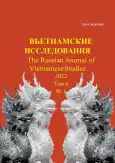Повелитель джунглей: образ тигра в фольклоре Вьетнама
- Авторы: Легостаева А.С.1
-
Учреждения:
- Государственный музей Востока
- Выпуск: Том 6, № 1 (2022)
- Страницы: 5-16
- Раздел: Научные исследования
- URL: https://journal-vniispk.ru/2618-9453/article/view/100487
- DOI: https://doi.org/10.54631/VS.2022.61-100487
- ID: 100487
Цитировать
Аннотация
Образ тигра прочно закрепился в мировом искусстве и литературе. Царственный облик и грация движений, обманчивое спокойствие и внезапная трансформация в свирепого хищника не могли оставить равнодушными людей творческих, посвящающих ему свои произведения.
На примере редких материалов, связанных с суевериями и фольклором Вьетнама, автор рассматривает связь тигра с человеком, определяя его место в духовной жизни и устно-поэтической традиции жителей страны.
Полный текст
Открыть статью на сайте журналаОб авторах
Альбина Сергеевна Легостаева
Государственный музей Востока
Автор, ответственный за переписку.
Email: albinalegostaeva@yandex.ru
зав. отделом выставок и постоянных экспозиций
Россия, 119019, Москва, Никитский бул., 12АСписок литературы
- Денисович Ю. В дикой природе Вьетнама осталось не более пяти тигров // ТАСС. 21.04.2016. URL: https://tass.ru/obschestvo/3226998
- Доан Зиой. В джунглях Юга. М.: Детская литература, 1972.
- Дюран М. Техника и пантеон вьетнамских медиумов (донг) // Миниатюрные сады стран дальневосточного культурного региона. СПб.: Наука, 2007.
- Кнорозова Е.Ю. Духовная культура Вьетнама. Традиционные религиозно-мифологические воззрения вьетнамцев / отв. ред. Н.В. Колпакова. СПб.: БАН, 2020.
- Корбетт Д. Храмовый тигр. М.: Наука, 1964.
- Маретина С.А. Образ тигра в племенной мифологии Индии // Азиатский бестиарий. Образы животных в традициях Южной, Юго-Западной и Центральной Азии: Сб. статей. СПб.: МАЭ РАН, 2009. С. 87–95.
- Маретина С.А. Тигр/лев в мифологической традиции индийцев // Бестиарий II. Зооморфизмы Азии: движение во времени. СПб.: МАЭ РАН, 2012. С. 41–56.
- Нгуен Фи Хоань. Искусство Вьетнама. Очерки истории изобразительного искусства. М.: Прогресс, 1982.
- Никулин Н.И. Вьетнамская литература X–XIX вв. М.: Наука, 1977.
- Серебряный ключ. Тайские сказки. М.: Востлит, 1963.
- Сингх Кесри. Тигр Раджастхана. М.: Наука, 1972.
- Сказки и предания Вьетнама / сост. Ю.Д. Минина. М.: ВШЭ, 2021.
- Сказки народов Вьетнама / сост. Н.И. Никулин. М.: Наука, 1970.
- Стратанович Г.Г. Народные верования населения Индокитая. М.: Наука, 1978.
- Стрельцова Л.А. Тигр в традиционном представлении непальцев // Бестиарий III. Зооморфизмы в традиционном универсуме. СПб.: МАЭ РАН, 2014. С. 84–92.
- Чой Ч. Образ тигра как национальный символ корейской культуры // Общество: философия, история, культура. 2017. № 3. C. 78–80.
- Шинкарёв В.Н. Кварц, кровь, одержимость: очерки традиционного мировоззрения горных народов Южного Вьетнама. М.: ИЭА РАН, 2002.
- Cadière R.P. Croyances et dictons populaires de la vallée du Nguón-Sơn [Кадьер Р.П. Верования и народные поговорки долины Нгуон-Сон]. Bulletin de l'Ecole française d'Extrême-Orient [Бюллетень Французской школы Дальнего Востока]. T. 1. 1901. P. 119–139.
- Chivas-Baron Cl. Stories and Legends of Annam / transl. from The French Contes el Légends de l'Annam by E. M. Smith-Dampier. London; New York: A. Melrose Ltd., 1920.
- Chuyên doi xua: contes plaisants annamites / traduits par Abel Des Michels [Приятные аннамские сказки / пер. Абеля Сен-Мишеля]. Paris: E. Leroux, 1888.
- Dumoutier G. Les chants et les traditions populaires des annamites [Дюмутье Г. Песни и народные традиции аннамцев]. Paris: E. Leroux, 1890.
- Dumoutier G. Les pagodes de Hanoi: étude d'archéologie et d'épigraphie annamites [Дюмутье Г. Пагоды Ханоя: изучение аннамской археологии и эпиграфики]. Hanoi, imp. de F.-H. Schneider, 1887.
- Giran P. Magie et religion annamites: introduction à une philosophie de la civilisation du peuple d'Annam [Гиран П. Аннамская магия и религия: введение в философию цивилизации народа Аннама]. Paris, A. Challamel, 1912.
- Guérin M., Seveau A. Auprès du Tigre sur les hauts plateaux de l'Indochine. Les mémoires de Pierre Dru, garde principal sur la route du Lang Bian en 1904 [Герен М., Сево А. По следам тигра на высоких плато Индокитая. Воспоминания Пьера Дрю, главного стража на Лангбяньской дороге в 1904 г. // Outre-mers [Зарубежье]. T. 96. N° 362–363, 1er semestre 2009. L'Atlantique Français. P. 155–192.
- Guérin M. Européens et prédateurs exotiques en Indochine, le cas du tigre. Repenser le sauvage grâce au retour du loup [Герен М. Европейцы и экзотические хищники в Индокитае на примере тигра. Переосмысление дикой природы благодаря возвращению волка]. Les sciences humaines interpellées, Pôle rural MRSH-Caen. 2010. P. 211–224. URL: https://hal.archives-ouvertes.fr/hal-00492359 (дата обращения: 11.11.2021).
- Hà Văn Tấn. Chùa Viêt Nam – Buddhist temples in Vietnam. Hà Nội: Khoa học xã hội, 1993.
- Landes A. Contes et légendes annamites [Ланд А. Аннамские сказки и легенды]. Saigon: Imprimerie Coloniale, 1886.
- Nguyễn Thanh Lợi. Cọp trong văn hóa dân gian Đông Nam Bộ [Нгуен Тхань Лой. Образ тигра в народной культуре Юго-Востока] // Tạp chí Nghiên cứu và Phát triển [Изучение и развитие]. Số 1 (78). 2010. P. 3–16. (На вьетн. яз.).
- Phan Văn Lương. Huyền tích miếu Ông Cọp [Фан Ван Лыонг. Легенда о храме Господина Тигра]. 02.08.2016. URL: https://cand.com.vn/Muon-mau-cuoc-song/Huyen-tich-mieu-Ong-Cop-i399424. (На вьетн. яз.).
- Pouchat J. Superstitions annamites relatives aux plantes et aux animaux [Пуша Ж. Суеверия аннамитов, касающиеся растений и животных], II // Bulletin de l'Ecole française d'Extrême-Orient [Бюллетень Французской школы Дальнего Востока]. T. 10. 1910. P. 585–611.
- Taboulet G. Le bestiaire indochinois. La faune sauvage de la Cochinchine française il y a cent ans [Табуле Г. Индокитайский бестиарий. Животный мир французской Кохинхины сто лет назад]. Paris: Académie des Sciences d'Outre-Mer, Nouvelle série n°7, 1978.
- Vassal G. Mes Trois Ans D'Annam [Вассаль Г. Мои три года Аннама] // Le Tour du monde [Вокруг света]. Т. XVII. Paris, 1911. P. 61–108, 253–30
Дополнительные файлы












